ISSN ONLINE(2319-8753)PRINT(2347-6710)
ISSN ONLINE(2319-8753)PRINT(2347-6710)
P.Saravanan1 and G.VijayaGowri2
|
| Related article at Pubmed, Scholar Google |
Visit for more related articles at International Journal of Innovative Research in Science, Engineering and Technology
In this paper renewable energy sources, which are expected to be a promising alternative energy source, which are continually replenished such as sunlight, wind, biodiesel. About 16% of global final energy consumption comes from renewable resources. To have sustainable growth and social progress, it is necessary to meet the energy need by utilizing the renewable energy resources like biofuels, solar, wind, etc. Biodiesel is a renewable fuel, which is an alternative to petroleum-based diesel fuel. Diesel fuel is used for commercial trucks, home and industrial generators, and heating oil, So demand for diesel passenger vehicles grows. The need to integrate the renewable energy like biofuels and wind into power system is to make it possible to minimize the environmental impact on conventional plant. Biodiesel production is the process of producing the biofuel through the chemical reaction called trans-esterification. This involves vegetable or animal fats and neem oil, sunflower oil, pongamia oil, soybean oil, palm oil, mustard oil being reacted with short-chain alcohols (typically methanol or ethanol).The wind power system is well established technologies for renewable energy sources. Each technology has its own individual instrumentation requirements to measure and control system variables. MATLAB software is used to simulate the model. Several endurance will be carried out to investigate wind and diesel- biodiesel blend grid connected generating system. In future work, the MAT Lab will be used to analyze the grid connected hybrid system consisting of wind, biodiesel and energies.
Index Terms |
| Hybrid energy, Wind energy, Biodiesel, PWM Inverter, Diesel engine. |
INTRODUCTION |
| India ranks 5th in wind power generation as on date, with US having the highest installed capacity of over 25GW, with Germany, Spain, China following with 24,17 and 12 GW respectively. In the Indian wind power development, the primary driving factor has been feed in tariffs and accelerated depreciation and other tax incentives for domestic wind systems. Hence most of the investors in Wind Energy, apart from the demonstration projects of State and Central Governments are all from the following table. |
| There are more than 3500 wind farm having capacities of WEG (Wind Electric Generator) from 225 kW to 2000 kW and most of the owners have bought either from Vendors |
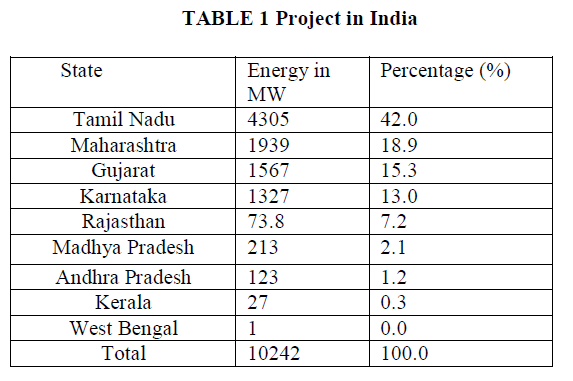 |
| (system integrators) or manufacturers having joint ventures or licensing agreement with Foreign collaborators mostly of European origin. India has got an ambitious plan to exploit in full, the wind energy potential in the Country which is estimated to be 48 GW of which only 20% has been exploited as on date. However, this amounts to about 3 to 5% of net electricity generated in India. |
| At present biodiesel is being used as the alternate fuel for a number of vehicles. Biodiesel can be used as the fuel for vehicles in pure form or it can be blended with petroleum diesel in any ratio and be used as the fuel. The blend of 20% of biodiesel and 80% of petroleum diesel is designated as B20, while 100% biodiesel is designated as B100. The B20 can be used in almost all the diesel engines without carrying out any changes in the engine. As the content of biodiesel increases in the biodiesel blend beyond B20 the users must know the issues of potential impact on the engine warranties. You may also have to change the hoses and gaskets for the engine. |
| The B100 is a pure biodiesel that can also be used as the fuel for the vehicles using petroleum diesel engines with some changes in the hoses and gaskets of the engines. As the proportion of biodiesel increases in the blend a number of concerns need to be addressed. Firstly the energy content of biodiesel is lesser than petroleum diesel so with increasing content of biodiesel the performance of engine is bound to be affected. |
WIND POWER EQUATION |
| Although the power equation above gives us the power in the wind, the actual power that we can extract from the wind is significantly less than this figure suggests. The actual power will depend on several factors, such as the type of machine and rotor used the sophistication of blade design, friction losses, and the losses in the pump or other equipment connected to the wind machine. There are also physical limits to the amount of power that can be extracted realistically from the wind. |
| However, significant areas of the world have mean annual wind speeds of above 4-5 m/s (meters per second) which makes small-scale wind powered electricity generation an attractive option. It is important to obtain accurate wind speed data for the site in mind before any decision can be made as to its suitability. Methods for assessing the mean wind speed are found in the relevant texts (see the References and resources ‘section at the end of this fact sheet). |
| The power in the wind is proportional to |
| • The area of windmill being swept by the wind |
| • The cube of the wind speed |
| The formula used for calculating the power in the wind is shown below: |
| Power = density of air x swept area x velocity cubed/2 |
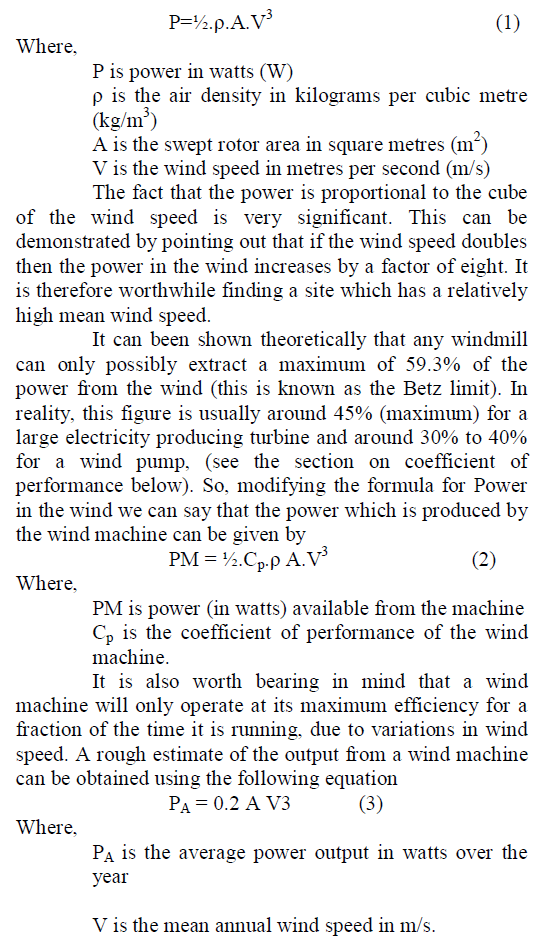 |
| A. Principles of Wind Energy Conversion |
| There are two primary physical principles by which energy can be extracted from the wind these are through the creation of either lift or drag force. The difference between drag and lift is illustrated by the difference between using a spinnaker sail, which fills like a parachute and pulls a sailing boat with the wind, and a Bermuda rig, the familiar triangular sail which deflects with wind and allows a sailing boat to travel across the wind or slightly into the wind. |
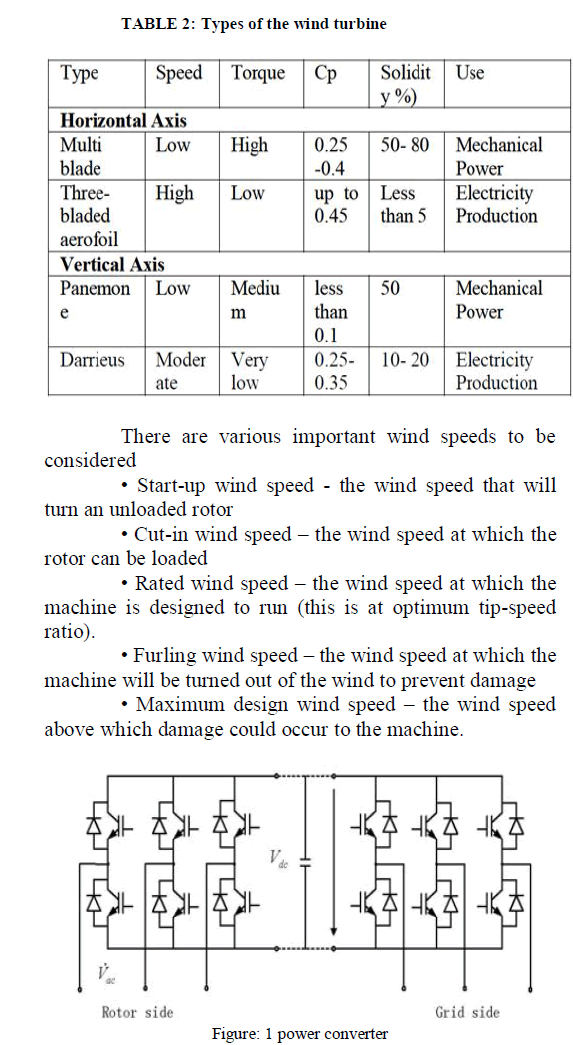 |
| B.PWM Converter |
| A device that converts dc power into ac power at desired output voltage and frequency is called an Inverter. Voltage Source Inverter is one in which the dc source has small or negligible impedance. In other words, a Voltage source inverter has a stiff voltage source at its input terminals.PWM control is a method to control the output voltage that is widely in application. In this method, a fixed dc input voltage is given to the inverter and a controlled ac output voltage is obtained by adjusting the on and off periods of the inverter components. |
THE BASIC PROCESS |
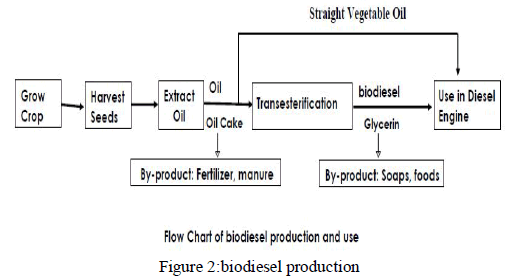 |
| A. Solvent |
| Biodiesel is a good solvent. Biodiesel can, if left on a painted surface long enough, dissolve certain types of paints. Therefore it is recommended to wipe any biodiesel or Biodiesel blend spills from painted surfaces immediately. |
| B. Performance |
| Operationally, biodiesel performs very similar to low sulphur diesel in terms of power, torque, and fuel without major modification of engines or infrastructure. One of the major advantages of biodiesel is the fact that it can be used in existing engines and fuel injection equipment with little impact to operating performance. Biodiesel has a higher cetane number than diesel fuel. In over 15 million miles of in-field demonstrations biodiesel showed similar fuel consumption, horsepower, torque, and haulage rates as conventional diesel fuel. |
| C. Compatibility Of Biodiesel With Engine Components |
| In general, biodiesel will soften and degrade certain types of elastomers and natural rubber compounds over time. Using high % blends can impact fuel system components (primarily fuel hoses and fuel pump seals), that contain elastomeric compounds incompatible with biodiesel. Manufacturers recommend that natural or butyl rubbers not be allowed to come in contact with pure biodiesel. Biodiesel will lead to degradation of these materials over time, although the effect is lessened with biodiesel blends. If a fuel system does contain these materials pure biodiesel is being used, replacement with compatible elastomers is recommended. The recent switch to low sulphur diesel fuel has caused many OEMs to switch to components suitable for use with biodiesel |
| D. Biodiesel Vs Vegetable Oil Systems For The Farm |
| For diesel engines, there are two main fuel alternatives to diesel. The first approach is to modify the fuel to run in the vehicle (which is biodiesel) and the second approach is to modify the fuel delivery system to use Straight Vegetable Oil (SVO). With a SVO system it is necessary to reduce the viscosity of the vegetable oil by heating the vegetable oil. |
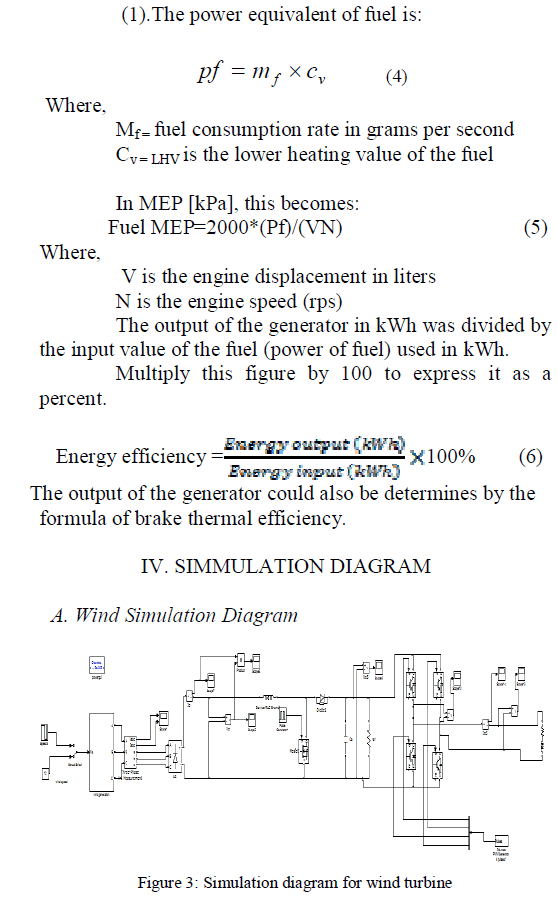 |
| The wind energy conversion system operating for the variable speed operation. The tip speed ratio is defined as the ratio of the speed of the extremities of a windmill rotor to the speed of the free wind. Drag devices always have tipspeed ratios less than one and hence turn slowly, whereas lift devices can have high tip-speed ratios and hence turn quickly relative to the wind.The wind energy conversion output efficiency is 40%.So the seasonally time only get the power from wind turbine. |
| B.Biodiesel Simmualtion Diagram |
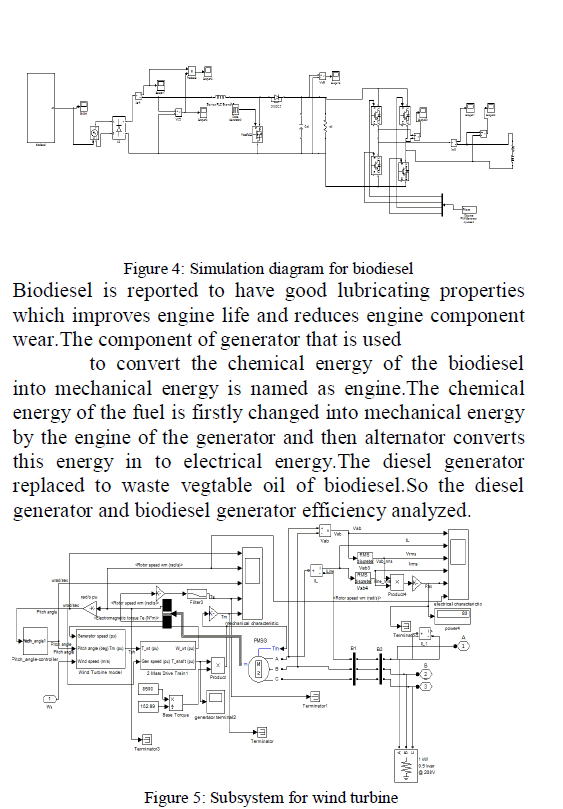 |
| converting the kinetic energy of the turbine rotation into heat. This method is useful if the kinetic load on the generator is suddenly reduced or is too small to keep the turbine speed within its allowed limit. Cyclically braking causes the blades to slow down, which increases the stalling effect, reducing the efficiency of the blades. |
| This way, the turbine's rotation can be kept at a safe speed in faster winds while maintaining (nominal) power output. This method is usually not applied on large grid-connected wind turbines. |
| Windmill can only possibly extract a maximum of 59.3% of the power from the wind . In reality, is usually around 45% (maximum) for a large electricity producing turbine and around 30% to 40% for a wind pump, (see the section on coefficient of performance below). |
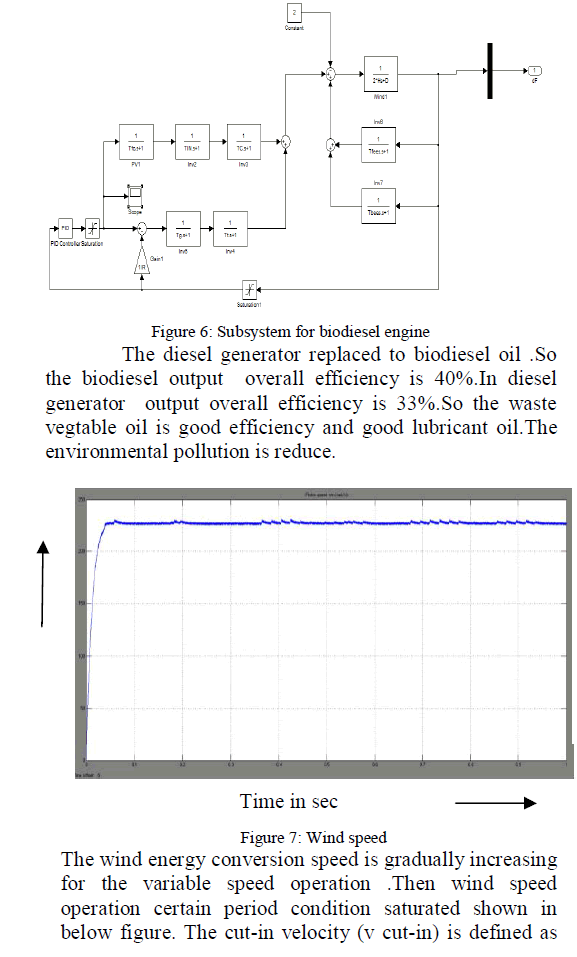 |
| the wind speed at which the turbine starts to generate the power. |
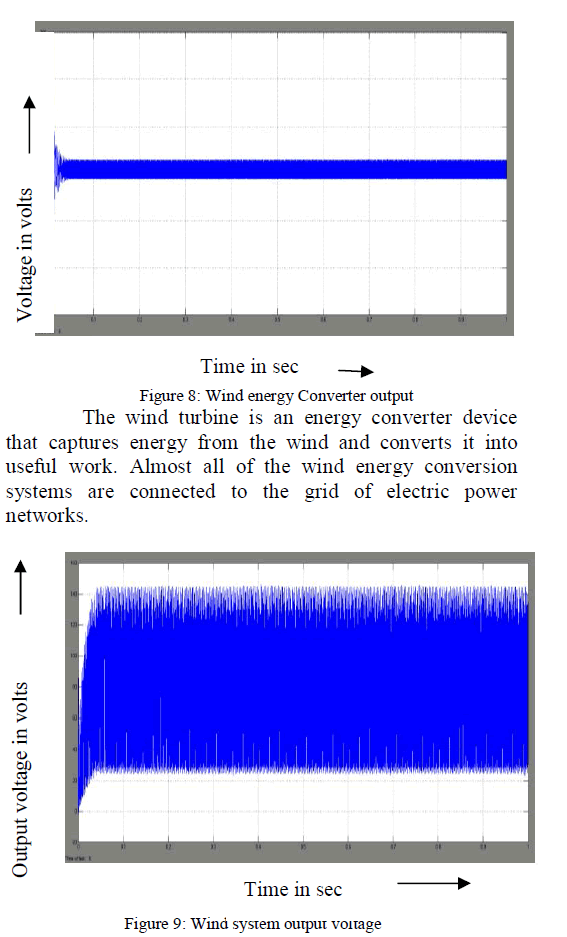 |
| The wind energy conversion system output voltage is also increasing to initial condition and certain period saturated the waveform.So the wind energy is depending upon the speed and time. The variable speed operation only geting the more amount of output.The wind speed is increasing at the same time power also increasing.So the wind speed characteristics waveform speed is gradually increasing and saturated the curve. |
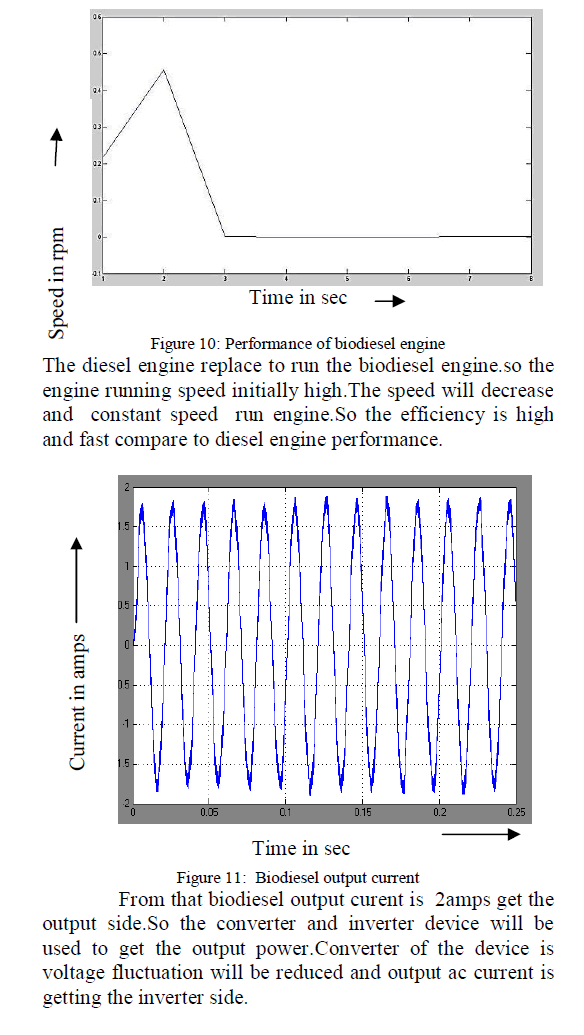 |
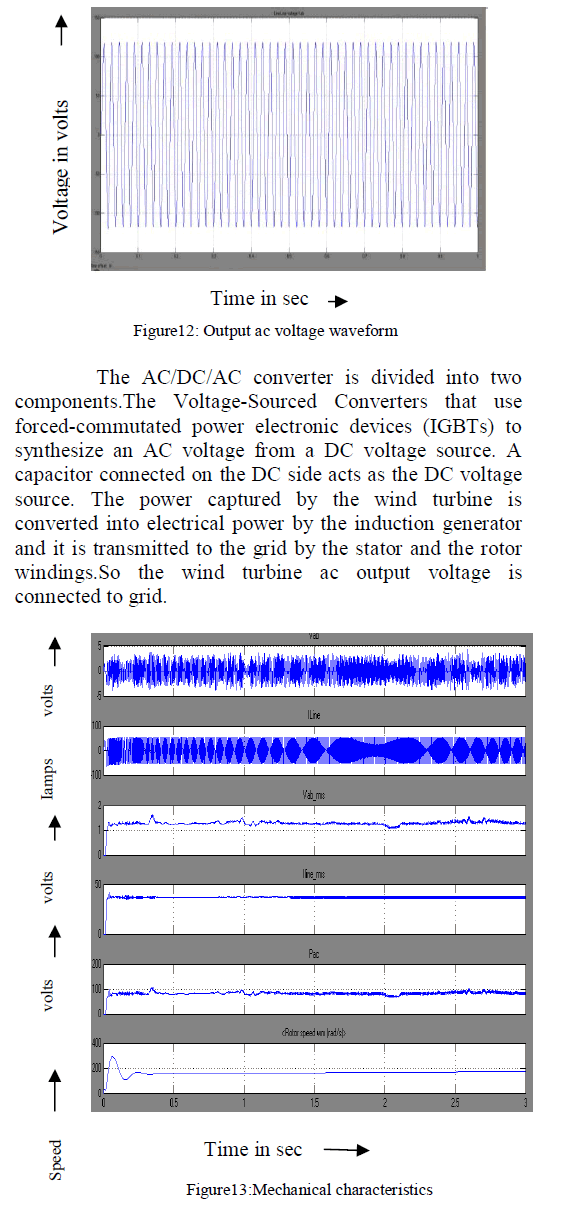 |
| The PMSG technology allows extracting maximum energy from the wind for low wind speeds by optimizing the turbine speed, while minimizing mechanical stresses on the turbine during gusts of wind. The optimum turbine speed producing maximum mechanical energy for a given wind speed is proportional to the wind speed .Another advantage of the PMSG technology is the ability for power electronic converters to generate or Turbine.In this waveform line current and voltage value Shown in figure. |
SIMMULATION RESULT |
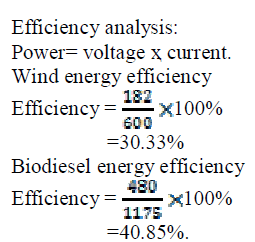 |
CONCLUSION |
| The wind energy conversion system output is simulated using MATLAB. The behavior of converters and the output of wind energy conversion system at variable speed of wind generator are analyzed in this paper. When the wind power is increased, the efficiency of the output is also increased. The converter system can regulate the dc bus voltage with nearly sinusoidal line side current and low harmonics distortion. The system can track the maximum output power by various wind speeds. The wind energy conversion system obtains the power only at the time of season. But the biodiesel system obtains the power continuously. The biodiesel is reported to have good lubricating properties which improve engine life. Simulation result shown that biodiesel electric power generation system achieves superior capability of efficiency. The efficiency of Wind power generation system is 30% at a wind velocity of 9 meters per second (about 20 mph) and biodiesel efficiency is 40%.These plants ensure a continuous power output and keeping fuel costs down due to the CO2 emissions. By combining the wind turbines with biodiesel engines, the efficiency of the biodiesel is high, so these plants ensure a continuous power output. |
References |
|